How 'Saturday Night' Leans Into Counterculture '70s Fashion to Recreate the Original 'SNL' Cast's Threads
Costume designer Danny Glicker worked extra hard to pay homage to the debut episode’s chaotic aesthetic.
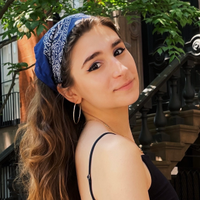
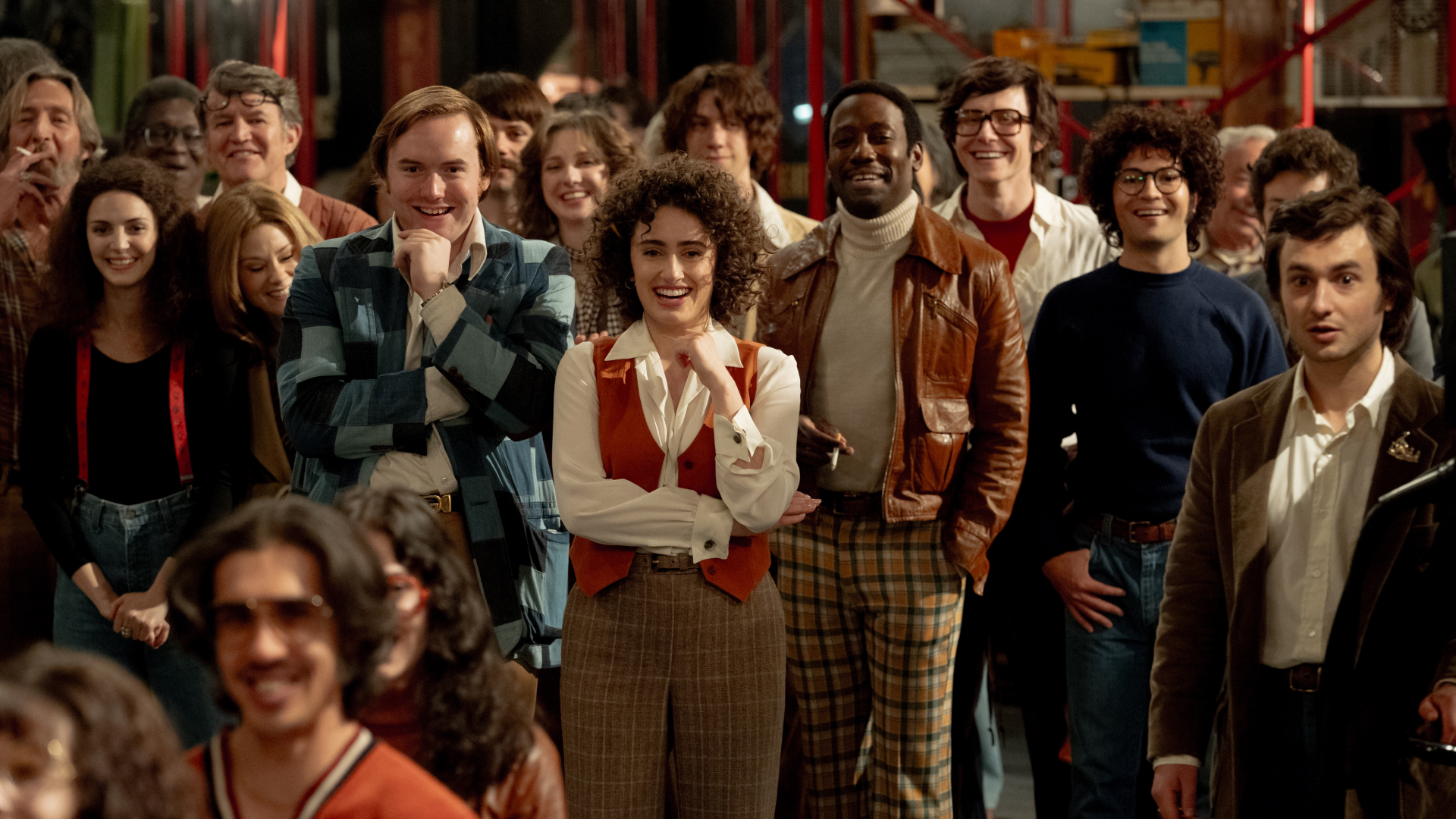
Documenting the hour and a half before the first broadcast of Saturday Night Live on October 11, 1975, Jason Reitman’s new film Saturday Night illustrates just how much chaos played out before the novice cast announced, “Live from New York.” There’s a haphazardness in the unfinished scripts, set pieces, and run-of-show schedule; even the clothes on the Not Ready for Prime Time Players are barely put together.
Both a ‘70s period piece and a love letter to a special moment in comedy history, the film’s wardrobe amplifies how newly-minted SNL boss Lorne Michaels and his troupe of rising comics were taking a counterculture approach to launching the late-night show. Costume designer Danny Glicker mimicked this radicalness when recreating the looks worn by the real-life people the film portrays—from bell bottoms to mix-matched thrift shop threads to their sketch costumes.
Glicker “wanted to help create the tension,” he recalls to Marie Claire. “I said at one point, ‘Jason, I want to dress the actors in such a way that not only does it look like this show is not going to go on in an hour and a half, it doesn't look like it's going to go on in a week.’”

Costume designer Danny Glicker (right) talks to Cory Michael Smith as he adjusts Chevy Chase's "Weekend Update" suit on the set of Saturday Night.
The costume designer explains that he was thrilled to work on the project, given his interest and familiarity with the ‘70s comedy scene, and the ability to tap into a “grimey” kind of mid-century fashion that’s not often depicted on-screen. He wanted to emphasize the “looseness and inventiveness” of the time, whether he was dressing Ella Hunt as Gilda Radner or Matt Wood as John Belushi.
“Every single person on this set was there for the same reason—and that was to fully live in the creative chaos of this moment,” Glicker says.
With Saturday Night releasing in theaters wide on Oct. 11 (commemorating when the debut episode aired) Glicker spoke to Marie Claire about his archival research, Dylan O’Brien’s short shorts, and finding Lorne Michaels’ legendary reindeer sweater.
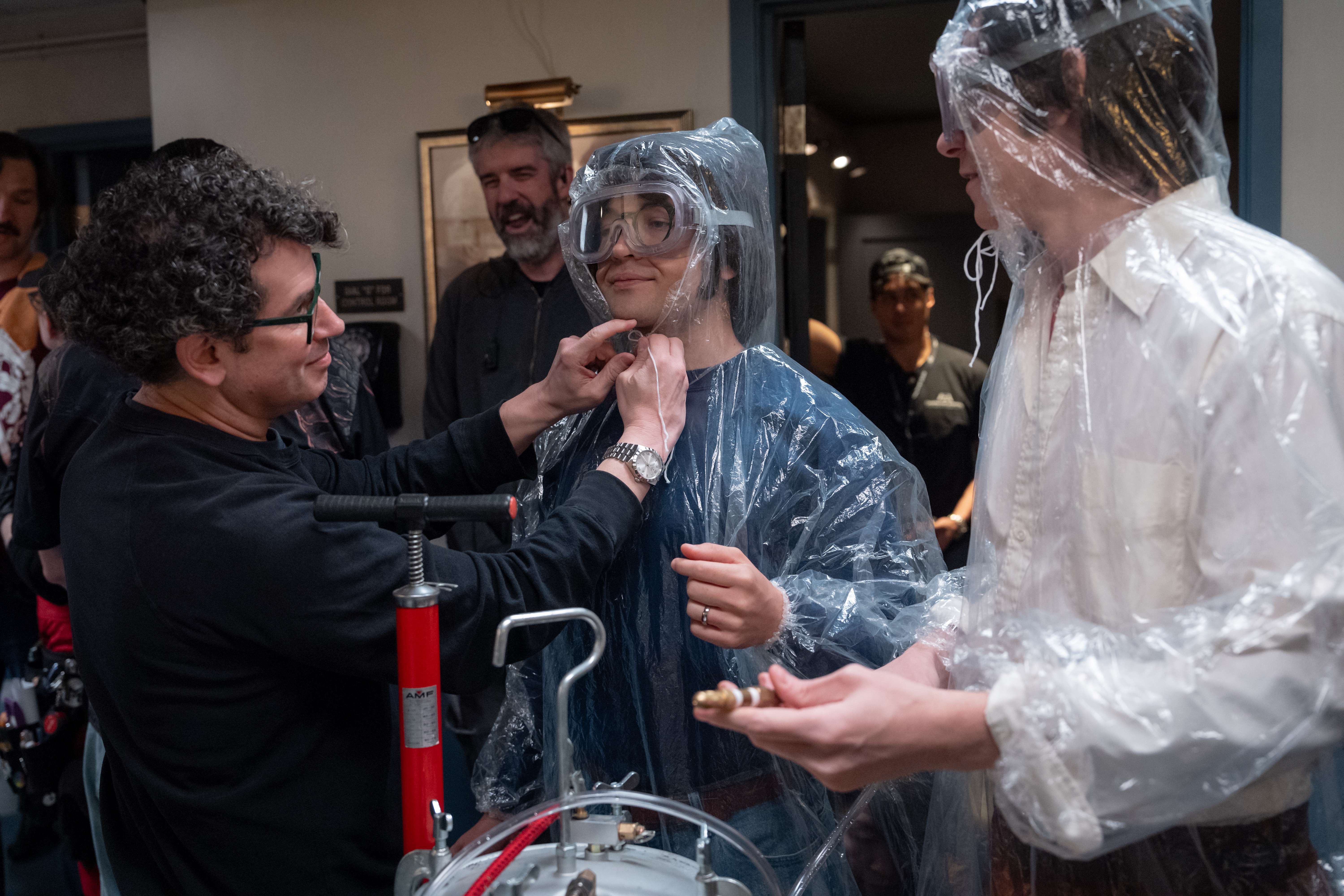
Glicker helping several Saturday Night cast members get ready to shoot a scene.
MC: The costuming in Saturday Night is two-fold because you have the ‘70s fashion and then the recreated SNL sketch costumes. Where did your research start?
Get exclusive access to fashion and beauty trends, hot-off-the-press celebrity news, and more.
Danny Glicker: I had already read Gilda [Radner]'s autobiography; I had already read Alan Zweibel’s autobiography; I'd listened to so many audio books about all these people that it was sort of like revisiting with old friends.
I wanted to start with the inside world of who these people were and unpack who they were before they became iconic. I was careful to put a firewall up after the show, so my research ended on October 11, 1975. Then I wanted to find ways to honor their humanity, to use the clothes to express their struggle as starving artists making nothing. I wanted to show that in the clothes they're cobbling things together.
MC: Were you using vintage pieces?
Glicker: Even though it's a ‘70s movie, I had tons of vintage pieces throughout that would've been vintage in the ‘70s [because] many of the characters themselves [were] buying stuff from thrift shops or wearing things to death.
In a lot of cases, because some of the clothes are 50- 60-years-old, I'm rebuilding a ton of stuff. Even though they look like they're in these worn-out threads, they were pieces I had to create and then kill. We had talented fiber artists making everything look so tired and worn.
In the case of Tommy Dewey playing Michael O'Donoghue, his character was one that in real life dressed almost exclusively in vintage. Because of his fire gag where we see him lighting script pages on fire at one point, everything had to be built in multiple because we had to do a fireproof version of one of his outfits. We were building pieces based on vintage pieces: the 1940s high-waisted, pleated pants and vest. I worked hard to make sure there was something a little curdled about his look. So we found this fabulously awful fabric for the back of his vest. His character was a cool guy of that era who was showing his disdain for the institutions of that era through all of his vintage clothes.
The blouse that Rachel Sennott wears [as writer Rosie Shuster] is based on a ‘50s blouse, so she's wearing vintage in the ‘70s. I remember having a lot of sleepless nights because her collar is a ‘50s collar, not a '70s collar, and I was like, ‘Is this going to ruin it?’ I have to trust those details are going to make it richer because it's not a fashion magazine and it's not a catalog. It's real life. We're seeing these people existing in their reality in 1975.
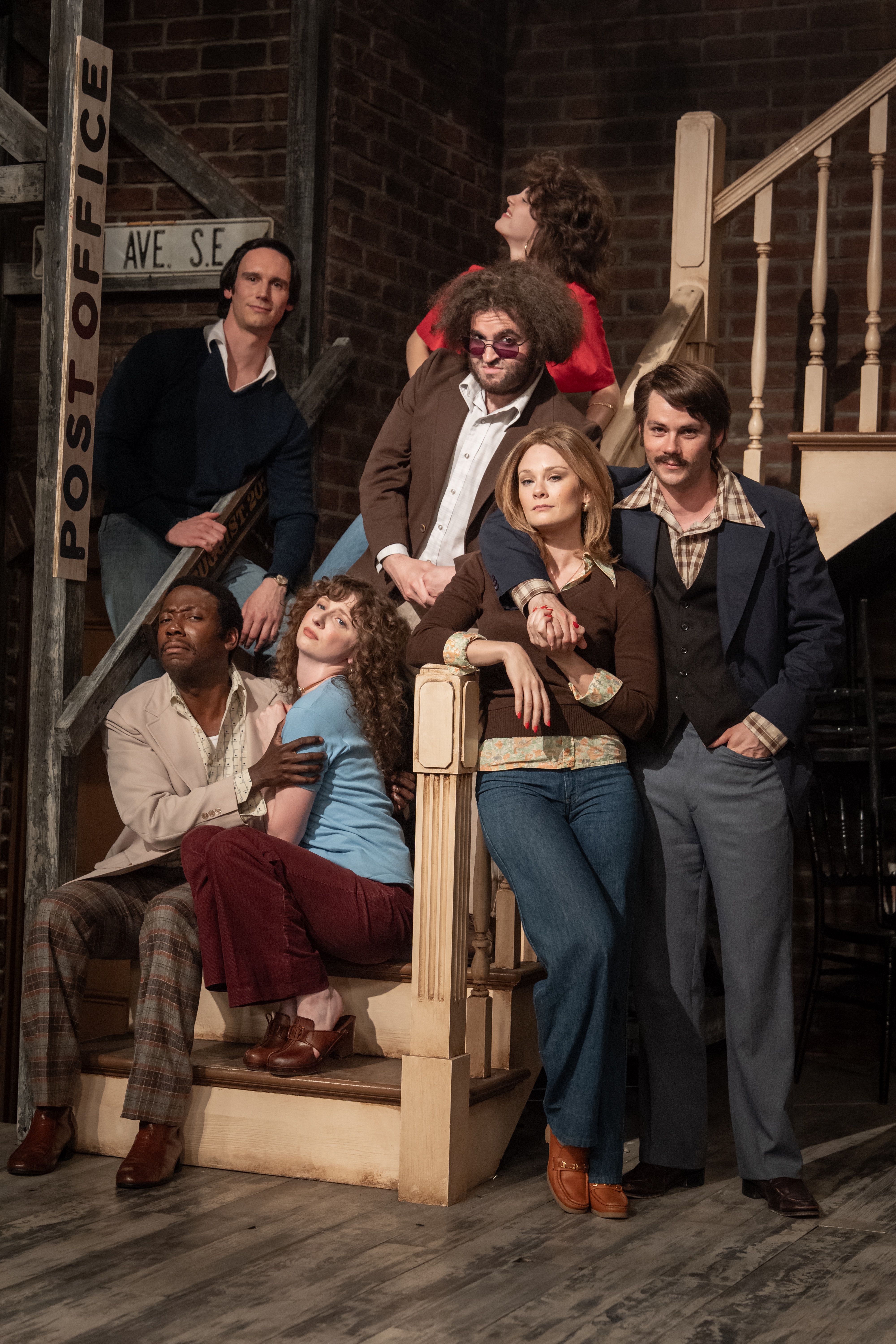
From left: The Not Ready for Prime Time Players Garrett Morris (Lamorne Morris), Chevy Chase (Cory Michael Smith), Laraine Newman (Emily Fairn), John Beluschi (Matt Wood), Gilda Radner (Ella Hunt), Jane Curtin (Kim Matula), and Dan Ackroyd (Dylan O'Brien).
All the collars and double collars are so pronounced—they’re like their own statement piece.
Glicker: That was a big conversation that Jason and I had early on: making sure that, even though we had something like 85 speaking roles, every character had a secretly distinctive thing. So, if you turn your head and look at them, you immediately know who you're looking at. I didn't repeat anything. The idea was that, even though we're intentionally overwhelming the audience with this incredibly varied cast, each person has their own visual trademark. That was a wonderful challenge.
Where did you start with the recreated sketch costumes? Did you watch old footage or is there an existing SNL archive that you visited?
Glicker: There's not an SNL archive, and I think that had to do with this era—the scrappiness. I think of that line where the stagehand says to Leo [played by Abraham Hsu], who's putting the bricks in [the stage]. He goes, ‘Why are you doing this? It's going to be gone in two weeks.’ I think that that was the attitude.
I did speak to the delightful Tom Broecker [who has been SNL’s costume designer for decades]. He was so sweet and delivered the news to me [that there is no archive]. He's like, ‘We might have the Coneheads’ collar.’
So, whenever you're working on something like this, there's an ephemeral quality to the clothes. I think that in the early seasons, there was a healthy mixture of very thoughtfully designed costumes, and every now and then, I would see examples of actors' pieces of their own closets entering the show. That's certainly the case for Garrett Morris' leather jacket, which I've seen him in in the show and in paparazzi photos, and I replicated it for this movie [for Lamorne Morris].
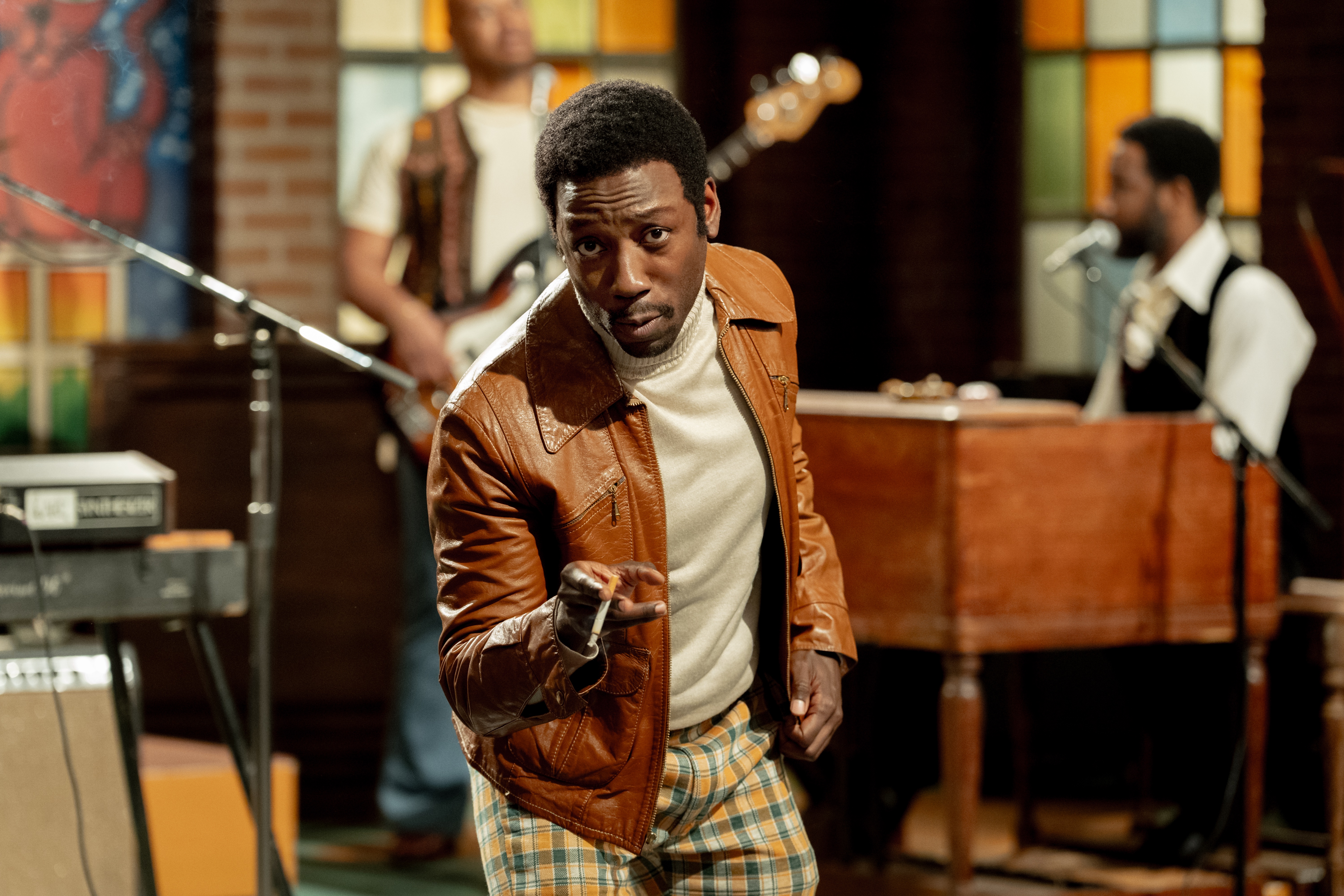
Lamorne Morris as Garrett Morris, who frequently wore a leather jacket on SNL during his run on the show.
A trick that I loved to play—this was my love letter to the fans of Saturday Night Live—was even though [the movie doesn’t] do a full run of show, every actor who plays a Not Ready for Prime Time Player, I fit them for a costume that their character wore in that episode. You’ll see it hanging on a rack and be like, ‘Oh, my god, that’s ‘[Land Shark],’” or, ‘That’s ‘Courtroom.’” I worked hard to replicate them in a way that would evoke both a visual response and an emotional response because we see clothes, but we feel the vibe too.
For me, this movie was so much about summoning this vibe—this kind of filthy, sweaty, slept-in, stinky counterculture ‘70s. I think that frequently when we see movies that take place in the ‘70s, people get so excited by the proportions and patterns of the clothes—which are exciting things—but they forget there's a real grime. We were looking at [movies like] Network and Dog Day Afternoon, even Shampoo and The Candidate. This is a movie that is teaming with texture. So for me to replicate the sketches, I wanted to replicate the experience of watching them—and that meant that everything had to look knocked down and edgy.
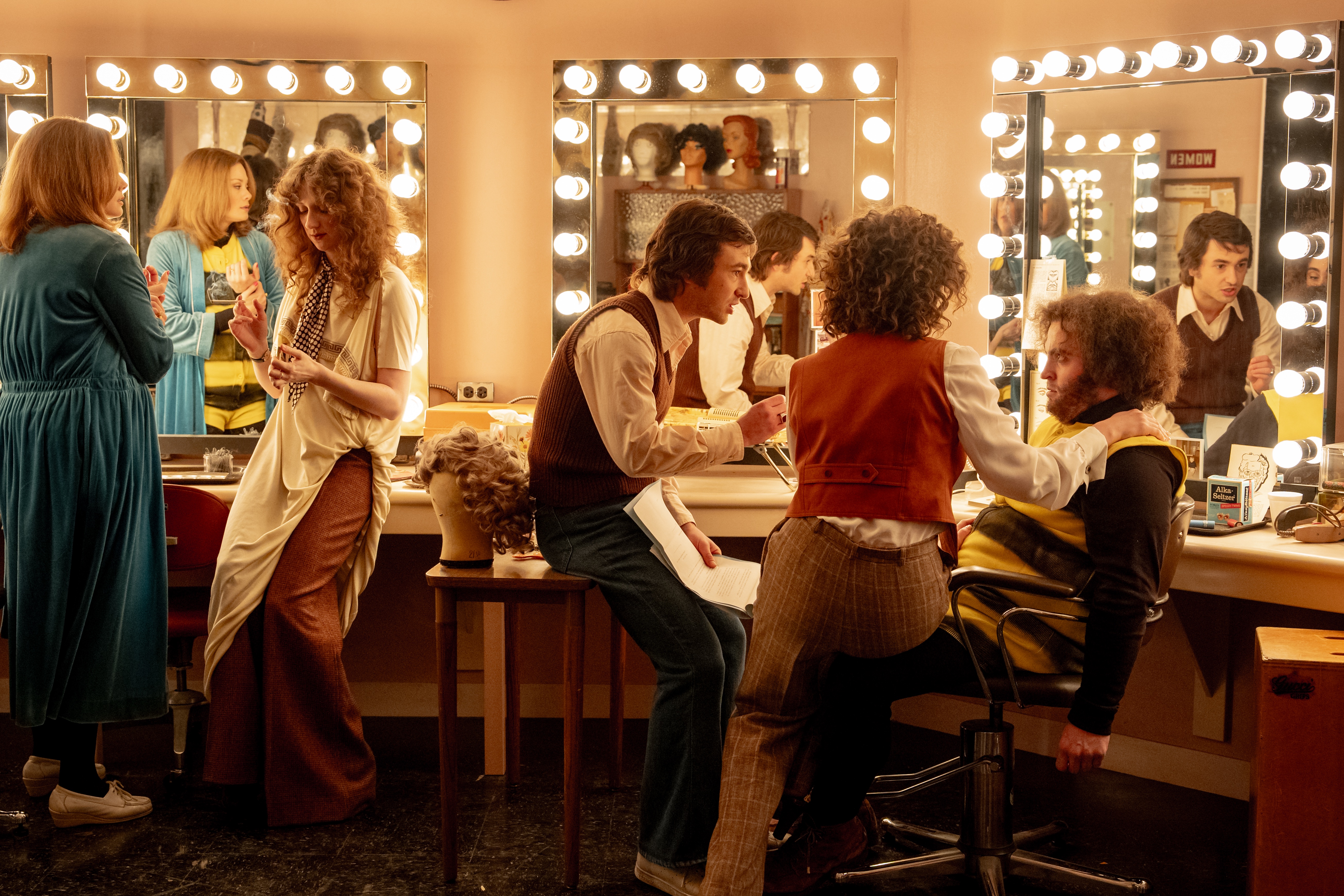
“The Killer Bees” costumes are particularly great. What was it like making those?
Glicker: It was really fun because, on the original bee costumes, the stripes are bleeding. They're spray painted on, which we incorporated in the movie. I had to work with my fiber artists for days and days to accomplish something that would make them look grimy and fast enough on these beautifully recreated bee costumes that we had to hand sew.
Every time we started spray painting, we did these very elaborate techniques where we would have bleed lines and we had to control the bleed lines. We would put in grime and splatter, but we also had to make sure that they looked like they were made for this episode. They couldn’t be filthy, but they had to look grimy—and there's a difference. Whenever I'm going into something where I'm working so hard to make it look so haphazard, I always think of the Dolly Parton quote: “It takes a lot of money to look this cheap.” It takes a lot of time to look this rushed.
For me, this movie was so much about summoning this vibe—this kind of filthy, sweaty, slept-in, stinky counterculture ‘70s.
MC: One of the movie’s big fashion moments is when Dylan O’Brien, as Dan Ackroyd, wears the short denim shorts in the “Hard Hats” sketch. What was it like crafting those shorts?
Glicker: I had all these still shots of the construction worker sketch on my wall. We got Dylan in a pair of vintage jeans from my personal collection because I wanted to make sure that we could cut them. I was measuring to the millimeter to the proportions of the original sketch because we really wanted it to match exactly how it was.
Dylan was so game. As much as the jeans are delightful, the thing that sells the outfit is Dylan O'Brien’s chest puff and how he does that rooster-cock-of-the-walk that Dan Ackroyd did originally. That was important because how you contort your body is going to affect everything, including what's going on with the end seam.
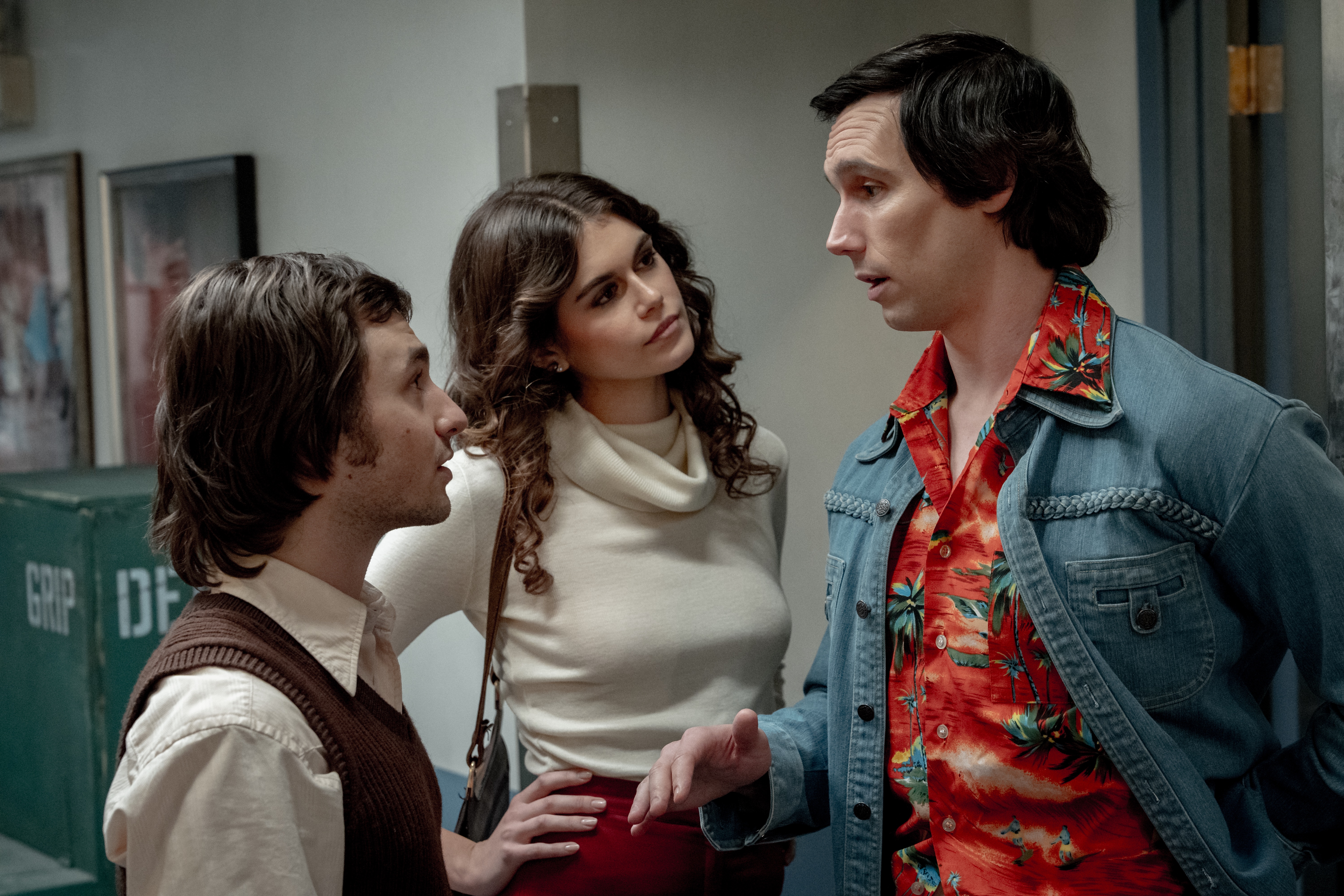
Lorne Michaels (Gabriel LaBelle) has a conversation with SNL star Chevy Chase (Cory Michael Smith) while his girlfriend Jacqueline Carlin (Kaia Gerber) looks on.
Did you feel like you saw anyone else find the real people they were portraying in the fittings?
Glicker. Every single actor. I view the fitting room as a lab for movement. We have lots of photos of them sitting, relaxing, reading, eating, pointing at things. I want to see their body moving in the clothes to know that they're empowered to go on set and be 100 percent the person and never have the clothing hold them back. I want the clothing to only infuse them with more reality.
I remember when Rachel Sennott came in for her first fitting, I gave her these fantastic platform heels from the ‘70s that are under her gorgeous, elephant leg bell bottoms. It was all about Rosie having this walk. Rachel was so much fun to move with and she was snapping down the hallway, super confident, super lovely, just as Rosie was—just shouting orders.
I did a ton of physical work with Chevy because we wanted to play up his lankiness. Chevy is a great verbal comedian, but also he's a great physical comedian. So I worked so closely with Corey [Michael Smith] to create the physicality. We were doing all sorts of tricks with height to give him this long lanky feel. We were even adjusting the lengths to make it look like he was too long for some pieces.
When we dressed [Ella Hunt as Gilda Radner], we kept her limber in these outfits that looked like, at any given moment, she could run up on stage and join a sketch even if she wasn't supposed to be in it. We wanted to honor the immediacy, the clownish, and the camaraderie that sketch comedians of that era were fully embracing.
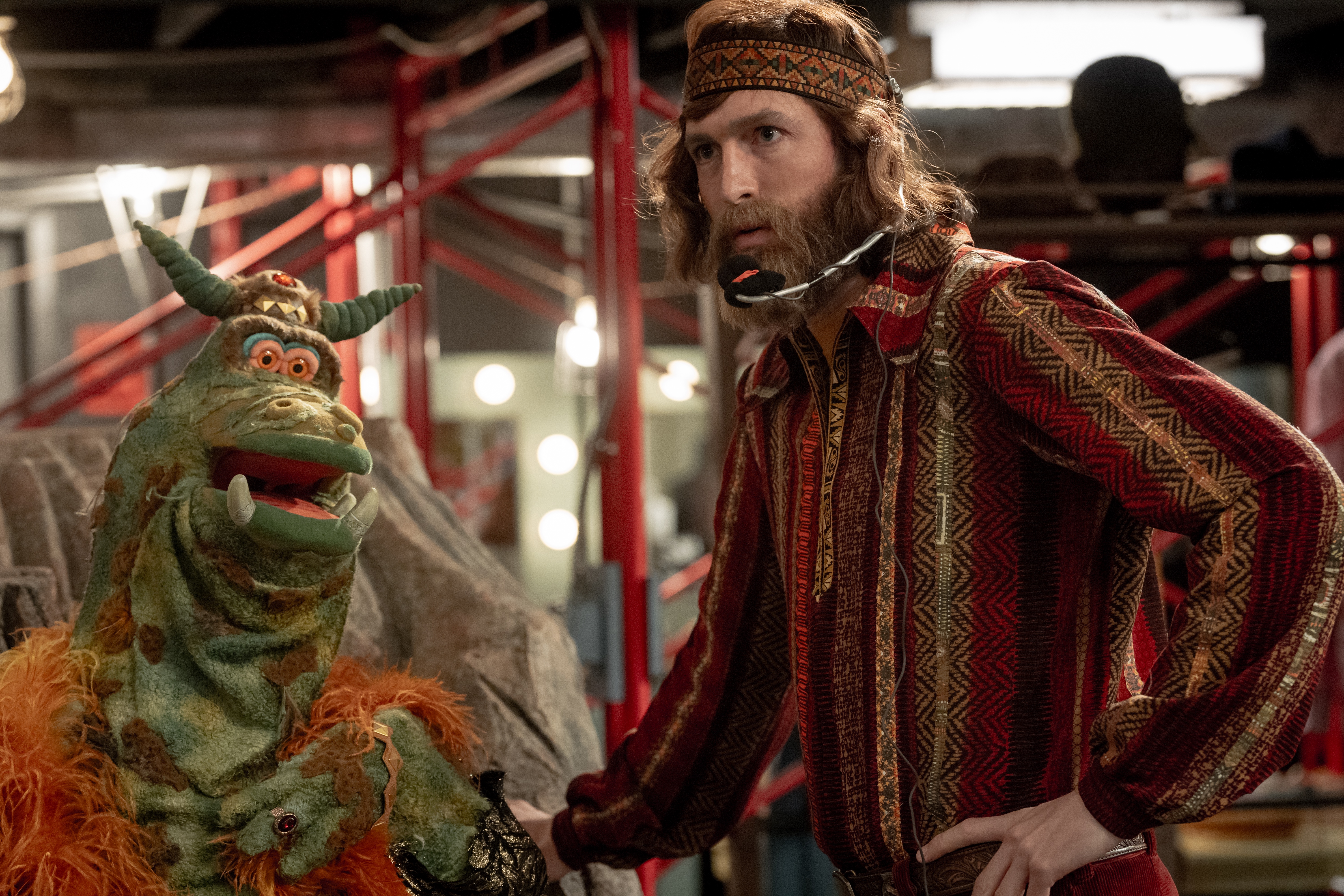
Jim Henson (Nicholas Braun) standing with one of his muppets.
There’s a fun bit involving Laraine and her quick changes, meaning, you had to design quick-change costumes yourself. Did you use any SNL behind-the-scenes magic to create those looks?
Glicker: What I love about this movie is that everything means exactly what it is, and it also means something else. The quick change costumes [were about] amping up the tension, but what it's showing is Laraine Newman is being told no. It’s about how every actor was in this fight for their comedic life.
[Emily Fairn, who played Laraine, and I] rehearsed those quick changes for hours. The hard thing is the first one's not supposed to work. We were creating rigged outfits—all sorts of highly choreographed shenanigans going on with the real customers working on my team, and then the on-set costumers on the Saturday Night Live costume team. It was very much a love letter to the perseverance of Lorraine Newman. I always viewed it as a way to honor the spirit of SNL. And then, of course, the sheer challenge of hiding one costume under another.
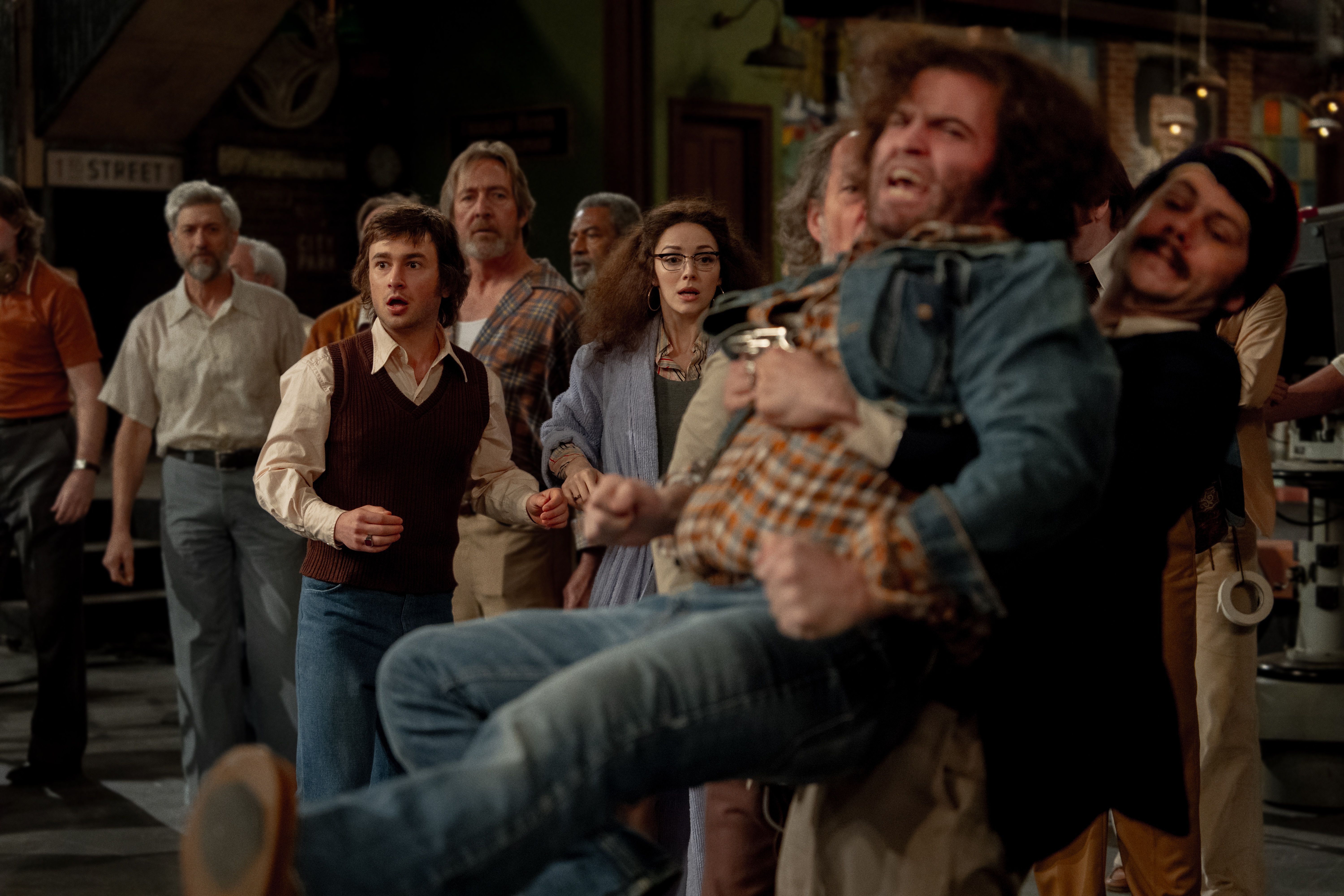
You clearly have so much love for SNL and the comedy of this era. Did you have a favorite piece or look in the film?
Glicker: You barely see it in the movie, but it's a piece that I have enormous affection for. Lorne was famous for wearing a reindeer sweater. There was an active discussion I had with Jason over whether or not we were going to use that sweater. When we were getting into the visual idea [of the film], it became clearer and clearer that the look I put Lorne in—which is based on a real look from Lorne in archival photos—we needed him to be a stable, clean foundation. This reindeer sweater, which I'm obsessed with, is very busy.
But that reindeer sweater makes a cameo in the movie: It's on his sofa in his office. I found the existing sweater [online and someone sent it to me]. I was freaking out the whole time because I was like, ‘Something's going to go wrong. It's going to get lost. I don't want to tell anyone that it exists.’ It’s the literal exact sweater that Lorne had. The sweater itself is a vintage sweater, so it’s not even from the ‘70s.
Jason [Reitman] posted [a photo of Gabriel LaBelle as Lorne in the sweater] and Laraine Newmen responded, “The reindeer sweater.” That made me so happy.
This interview has been edited and condensed for clarity.

Sadie Bell is the Senior Culture Editor at Marie Claire, where she edits, writes, and helps to ideate stories across movies, TV, books, music, and theater, from interviews with talent to pop culture features and trend stories. She has a passion for uplifting rising stars, and a special interest in cult-classic movies, emerging arts scenes, and music. She has over nine years of experience covering pop culture and her byline has appeared in Billboard, Interview Magazine, NYLON, PEOPLE, Rolling Stone, Thrillist and other outlets.